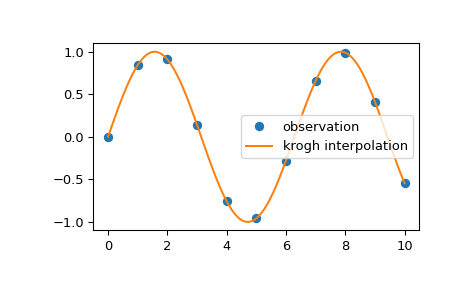scipy.interpolate.
krogh_interpolate#
- scipy.interpolate.krogh_interpolate(xi, yi, x, der=0, axis=0)[源]#
Krogh 插值的便捷函数。
更多详细信息请参见
KroghInterpolator。- 参数:
- xi类数组
插值点(已知 x 坐标)。
- yi类数组
已知 y 坐标,形状为
(xi.size, R)。解释为长度为 R 的向量,如果 R=1 则为标量。- x类数组
要评估导数的点或多个点。
- derint、list 或 None,可选
要评估的导数数量,或者为 None 表示所有可能非零的导数(即等于点数),或者是一个要评估的导数列表。此数量包括函数值作为“0阶”导数。
- axisint,可选
yi 数组中对应 x 坐标值的轴。
- 返回:
- dndarray
如果插值器的值为 R 维,则返回的数组将是导数数量乘以 N 乘以 R。如果 x 是标量,则中间维度将被删除;如果 yi 是标量,则最后一个维度将被删除。
另请参阅
KroghInterpolatorKrogh 插值器
注意
插值多项式的构建是一个相对昂贵的过程。如果需要重复评估,请考虑使用 KroghInterpolator 类(此函数就是使用该类)。
示例
我们可以使用 Krogh 插值来插值 2D 观测数据
>>> import numpy as np >>> import matplotlib.pyplot as plt >>> from scipy.interpolate import krogh_interpolate >>> x_observed = np.linspace(0.0, 10.0, 11) >>> y_observed = np.sin(x_observed) >>> x = np.linspace(min(x_observed), max(x_observed), num=100) >>> y = krogh_interpolate(x_observed, y_observed, x) >>> plt.plot(x_observed, y_observed, "o", label="observation") >>> plt.plot(x, y, label="krogh interpolation") >>> plt.legend() >>> plt.show()
